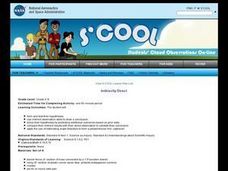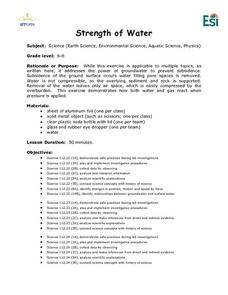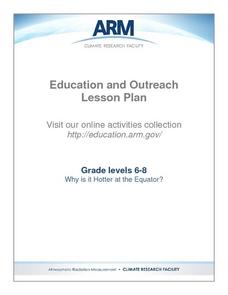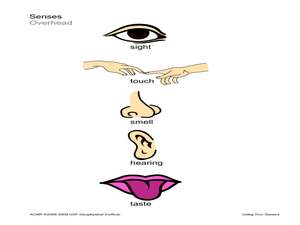Curated OER
Indirectly Direct
Students use prior knowledge of angle and lines as they conduct an experiment with a rolling marble to determine the shape of a mystery object located under a metal pie tin.
Curated OER
Indirectly Direct
Student form and test hyptheses using indirect and direct observation. They launch marbles to determine the shape of a hidden object.
Curated OER
Observations From the Past
Ninth graders explore direct and indirect evidence. In this astronomy lesson, 9th graders investigate the contribution of early astronomers to their field. They create a model of the solar system.
Curated OER
Models of Chemical Families
A simple activity for introductory chemistry classes is thoroughly explained in this lesson plan. Each individual receives a sealed box containing an unknown object. Inquisitors use indirect evidence to draw conclusions. This activity is...
Curated OER
Measurement
Students explore the necessity for standards of measurement and measure length, volume, mass and angles. In this measurement lesson plan, students use their hand and foot to measure objects in the room. They compare their measurements to...
Curated OER
Inverse (Indirect) Machines
Students observe relationships between quantities. Students complete activities for three different classes of levers. In groups, students build each type of lever. Students identify levers in their daily surroundings. Students observe...
NASA
Launch Altitude Tracker
Using PVC pipe and aquarium tubing, build an altitude tracker. Pupils then use the altitude tracker, along with a tangent table, to calculate the altitude of a launched rocket using the included data collection sheet.
NOAA
Ground-truthing Satellite Imagery with Drifting Buoy Data
Ground-truthing ... is it even a word? The last installment of a five-part series analyzes how scientists collect sea surface temperature data. Scholars use government websites to compare temperature data collected directly from buoys...
Curated OER
Springtime Flower Fun
Pupils study directional skills and participate in a scavenger hunt to find flowers. They compare, group and classify the flowers by their similarities and differences.
Curated OER
Cycles of Life in an Urban Habitat: Changes in Biodiversity
Second graders compare and contrast animate and inanimate objects. In this environmental science lesson, 2nd graders create simple food webs. They observe their environment and create a collage about it.
Curated OER
Runaway Universe
Students complete a hands on activity to determine how scientists use indirect observations to define problems that are not directly measurable. They complete an associate student handout.
Curated OER
Astronomy with a Stick
Students describe the movement of the Earth as it relates to the sun and
formulate a hypothesis for the movement and the changing length of the shadow. They express the relationship between the sun and the Earth and how that causes the...
Curated OER
User-friendly rivers
Learners explore and explain their connection to rivers through watersheds. They break into three groups. Each group needs: Blue enamel paint, Miniature objects to simulate a model river system, modeling clay, Tempera paint, Toothpicks...
Curated OER
Can You Tell By Touch?
Students feel inside a bag and use only their sense of touch to describe and identify one of the objects that is inside the bag.
Curated OER
What Shape Is It?
Students predict the shape of an unknown object by bouncing a ball on it. In this physics lesson, students relate this activity to how dolphins use echo-location to navigate. They analyze their lab result and discuss findings.
Curated OER
Aquifer Model
Students, after researching and brainstorming about aquifers and locating aquifer maps of Texas, participate in the building of a model of an aquifer complete with a pumping station. They also answer a variety of questions at the...
Curated OER
Inclined Plane and Pulley
Students describe how inclined plane and pulleys make work easier. For this physics lesson, students calculate work done and mechanical advantage of both simple machines. They collect data from the experiment and construct graphs.
Virginia Department of Education
Weather Patterns and Seasonal Changes
Get your class outside to observe their surroundings with a activity highlighting weather patterns and seasonal changes. First, learners take a weather walk to survey how the weather affects animals, people, plants, and trees during...
Peel-Public Health
What Is Respiratory Infection?
Empower your pupils to be germ stoppers! The heart of these lessons lies in stopping the spread of germs and keeping clean hands in order to prevent cases like a respiratory infection. It includes a game to simulate how germs can spread...
Curated OER
The Rifting of Pangaea and the Gettysburg Battlefield
Eleventh graders analyze and interpret an animated model of Earth’s rifting processes. In this Earth Science lesson, 11th graders connect Earth’s rifting processes with the Earth’s surface in the Gettysburg battlefield. Students apply...
Curated OER
Tree Identification
Students are introduced to the characteristics of trees and different techniques to identify them. They distinguish between a deciduous and a coniferous tree. Students describe at least four characteristics used to identify trees. They...
Curated OER
Strength of Water
Students perform experiments using flexible bottles of water and eyedroppers partially filled and placed in the bottle. They record what happens when they tighten the bottle lid and squeeze the bottle.
Curated OER
Why Is It Hotter At the Equator?
Students investigate the different heating effects of sunlight. They conduct an experiment that demonstrates the way sunlight strikes the equator, the poles and other parts of the globe.
Curated OER
Using Your Senses
Students make observations. In this sensory skills lesson, students use their senses as well as tools that sharpen their senses to make observations regarding foods and other items.

























